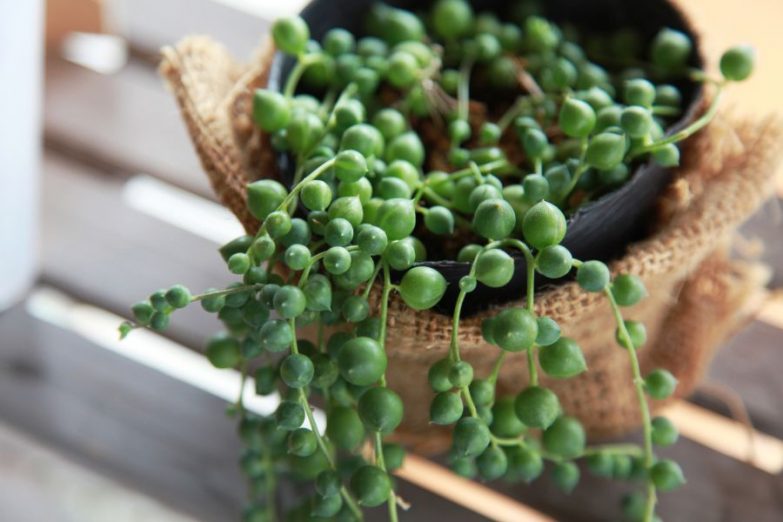Is your string of pearls plant dying or just not thriving? Well don’t worry, because this article is going to explain how to identify why your plant is struggling and teach you simple, practical steps to nurse your string of pearls plant (Senecio rowleyanus), back to health.
Why Is Your String Of Pearls Plant Dying?
The most common causes are:
- Overwatering
- Underwatering
- Too much light
- Not enough light
- Heavy soil
- Potting Problems
- Pests
- Humidity
- Heat
- Fertilizer
If your string of pearls plant is dying or failing, all you need to do is examine your plant to work out which of the above issues is causing the problem. Once you identify the cause, you can take practical steps to save the plant.
Let’s look at each cause in turn to help you get your string of pearls plant back to perfect health.
Overwatering
Overwatering can be a major problem and is the number one reason for a string of pearls plant dying. Overwatering can cause root rot, mushy leaves (balls) and mushy stems that cause the plant to weaken and die.
If water sits on the roots or the soil is too soggy, your plant will begin to look mushy at the crown and this problem will begin to spread. Eventually it will spread, leading to the death of the entire plant.
To prevent overwatering, you need to make sure you are watering the plant correctly, so the plant gets enough water to meet its needs, but not so much that it weakens or kills the plant.
The best way to water your string of pearls plant is to wait until the little balls begin to shrivel and shrink slightly. A well-watered string of pearls plant will have nice, plump green balls because this is where the plant stores its water and plump balls tell you that the plant is full of moisture. As the plant dries out and loses its moisture content, the little green balls or leaves will start to shrivel.
When you see the first signs of these leaves beginning to shrivel, it’s time to water the plant. Give the plant a deep and thorough watering, allowing all of the excess water to drain away. Then do not water the plant again until the leaves begin to shrivel and the soil begins to dry. You’ll need to watch the plant closely so that you do not underwater it with this method of watering.
Avoid watering your string of pearls plant on a schedule, as this is likely to lead to either overwatering or underwatering over time. There are so many variables that impact how much water your plant will need, including the size of plant, size of pot, type of potting media, growth rate, temperature, ventilation, light levels etc.
You are much better learning to observe your plant and identify the signs that it needs watered, rather than relying on a simple schedule. If you do struggle to remember to water your plants, you should set a schedule to check your plants. I normally do a tour of my houseplants once or twice per week, only watering those that need it and taking note of those that may need watered soon.
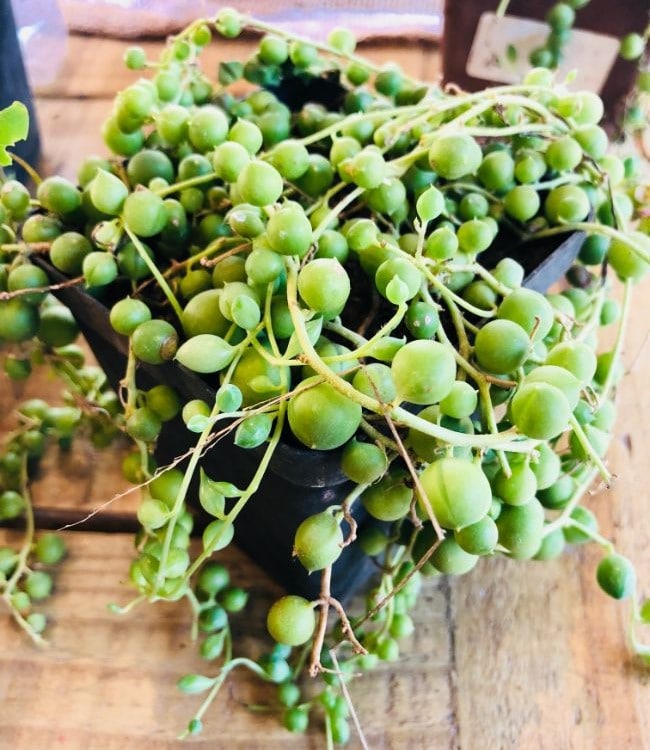
Overwatering Often Presents With Yellow Leaves
Yellow leaves are often a sign that your plant is being overwatered, and can be a sign of root rot. Root rot can cause significant damage to the plant before you realise what has happened. Often, the first sign of damage is when the leaves begin to lose their green hue.
The damaged roots prevent the plant from receiving all of the nutrition it needs from the soil, and the leaves cannot photosynthesize and so they begin to turn yellow.
To correct the problem, you will need to make sure you have the right kind of soil around the roots and that you are not overwatering your plant. If the entire plant has not turned yellow, it may still be salvageable. Even if the plant looks peaked and yellow, it is worth the effort to attempt to save it.
Allow the plant to thoroughly dry out before you water it again. Alternatively, you can very carefully change out the soil for a dryer soil with more perlite mixed in to increase drainage.
For more info on how to fix an overwatered plant, read this article, which covers the topic in more detail.
Pot Material Matters
Another aspect of watering is making sure your plant is in the right pot. Plastic pots will hold in a lot of moisture, whereas a pot made of terracotta will dry out more quickly. If you are having trouble with overwatering, you may want to switch to a terracotta pot to enable the soil to dry out more quickly.
Regardless of the material the pot is made of, make sure that there are good drainage holes in the bottom to allow all of the excess water to run out so that it doesn’t sit at the base of the roots and cause them to rot.
Underwatering
Another reason for a String of Pearls plant dying is not giving it enough water. This can cause the leaves to dry out, shrivel and turn brown. Eventually, the entire plant will shrivel and die if it does not receive enough moisture.
You can prevent underwatering by making sure to give your string of pearls a thorough drink of water whenever the soil dries out or the leaves look like they are beginning to shrivel. Don’t wait until they are completely shriveled up and turning brown to give it a drink.
If the balls and stems begin to turn purple and brown, you have waited too long to water the plant. Give it a long slow drink of water, and hopefully it will be able to green up again. Make sure you are watching closely and watering your plant often enough. Keep in mind that underwatering is definitely preferable to overwatering. These plants can tolerate a little bit of neglect.
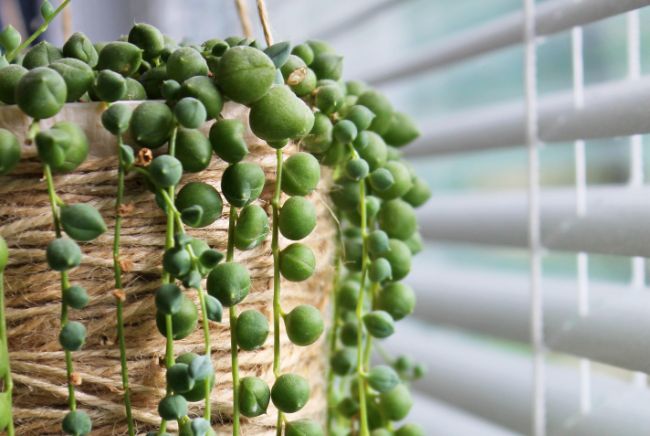
Too Much Light
String of pearls plants certainly like bright, indirect light. But they can easily get too much light if they are in direct sun, leading to burned, scarred, or scorched leaves. This could happen outside, especially in the harsh summer sun, or even indoors if your plant is growing in a sunny window.
If you notice your plant is looking scorched or has burn marks, you should move it immediately to a shadier location. If you are growing your plant outside, you may want to consider hanging it from a tree or porch that allows it to receive a little morning sun but shades the plant before the strong afternoon sun hits it.
If you are growing your string of pearls indoors, check and see if the afternoon light coming through the window is too strong or if it is too close to the hot glass of your window. If it is, move it out of the direct line of the sun. It will probably be just right in the space next to your window but not directly in front of the window.
You may need to move it across the room or even to the other side of the house so that it receives bright indirect light without getting sunburned.
Not Enough Light
String of Pearls plants need bright, indirect light to thrive. Consider placing yours near a sunny window but out of the direct line of sunlight. If you don’t have sufficient light in your home, you can move your string of pearls plant underneath a fluorescent light or place it under a grow light to give it a boost.
You’ll know the string of pearls isn’t receiving enough light if it gets leggy or if the plant seems like it just isn’t looking as full as it should. Move it to a brighter location, closer to a window, or under grow lights to get it to grow and look more full.
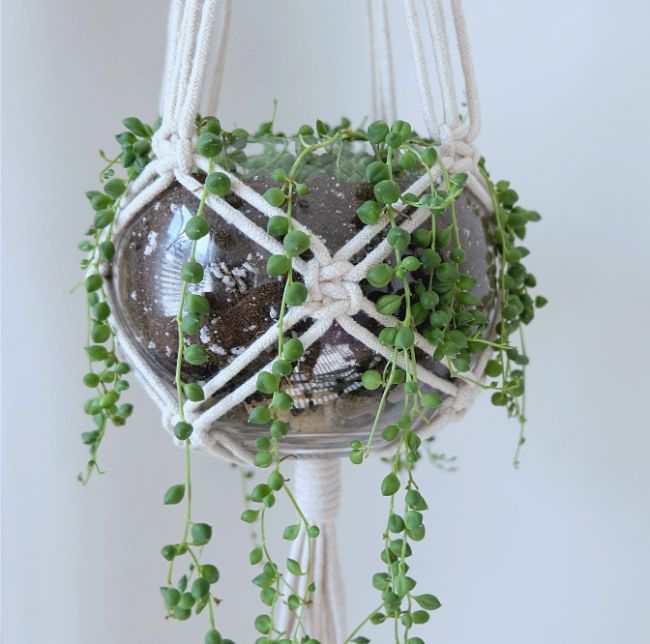
Heavy Soil
Heavy soil is another common cause of problems for string of pearls plants. Heavy soil is really any kind of soil that is dense, clumpy, and retains too much moisture.
Ideally, string of pearls plants need a lightweight, well-draining, cactus and succulent soil in a pot with good drainage holes. This will allow the plant to soak up water but also gives it a chance for the water to drain away before it harms the roots or the plant.
Soil that is too heavy will prevent the plant from having good drainage away from its roots. It will remain soggy even in between waterings and won’t allow water to drain easily.
Often, you’ll find that when you bring a plant home from the nursery or plant store, it will be in a general type of soil that is used for all plants, regardless of the plant type. This soil will probably be too heavy and hold in too much moisture for the string of pearls plant so you should change it when you bring it home.
If you don’t change the soil and you try to grow your plant in soil that is too heavy, soil aeration will be significantly reduced. When this happens, the roots will begin to rot and it may not be discovered until it is too late to save the plant.
Ideally, your string of pearls should be planted in a quality cacti and succulent soil. Either mix your own soil with peat moss, perlite and coarse sand, or purchase a commercial cactus and succulent soil mix that is airy and drains easily.
If you purchase a bag of soil at the store, it should feel light when you lift it. A heavy bag means it is a heavier type of potting soil and probably not a good fit for your string of pearls plant.
If the soil you purchase doesn’t drain well enough, you may need to add some additional perlite or vermiculite to lighten it up and promote good drainage. This will help protect your plant from soggy soil, mushy stems, and root rot.
Potting Problems
Using the wrong pot can also lead to a string of pearls plant dying. Since these plants can grow long trailing vines, they are often planted in lightweight, hanging pots to allow them to grow freely.
However, plastic pots can cause the soil to retain too much moisture, which causes rotting of the roots. When planting, opt for an unglazed clay pot to help the soil dry out more quickly and make sure there are drainage holes in the bottom.
Another issue that can arise with your string of pearls plant is potting it too far down in the pot. This will hinder air flow that the plant needs around its crown. Use enough well-draining soil in your pot so that the crown of the plant is nearly level with the top of the pot. This should leave enough room to water the plant but also allow the plant to have plenty of airflow so that the soil can dry out thoroughly in between waterings.
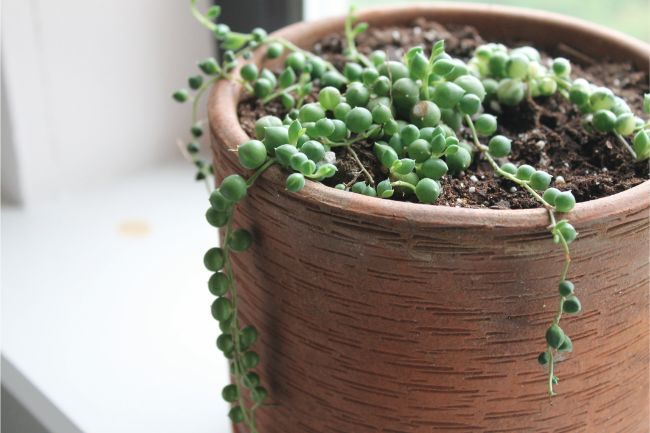
Pests
Pests are another reason your string of pearls plant may fail to thrive and even die. Minor infestations can weaken the plant, while heavy infestations may kill it. You can identify insect problems by inspecting your plants for the bugs on a regular basis. In addition, if you see sticky, yellowing or dropping leaves, you should definitely check your plant carefully for any unwanted pests.
Sticky leaves can occur even when the plant looks healthy, however, it often indicates a bug infestation has occurred. The stickiness is the residue left behind by the insects after they have sucked the sap out of your houseplant. These insects could be mealybugs, aphids, whitefly or scale.
To get rid of the insects, you can try spraying the plant with a mixture of water and soap and allowing it to dry. You may be able to gently wash off the insects with a steady, but not hard, stream of water.
White residue on the plants is also an indicator of an insect infestation. Again, you will need to use soapy water to remove the insects. You may need to treat them more than once.
Humidity
Low humidity isn’t a problem for string of pearls plants. In fact, these plants will do well in average home humidity, which is typically under 40%. However, high humidity could cause the soil to retain too much moisture.
If this happens, the plant will have trouble because the soil remains soggy after it has been watered. You may need to add more perlite to the soil to increase drainage and repot the plant in a terra cotta or similarly made pot.
Regardless, you won’t need to take any measures to increase the humidity around your plant- no pebble trays, misting, or grouping plants together is necessary for a string of pearls plant to thrive.
Heat
If you’re feeling comfortable in your home, your string of pearls probably is too. That means string of pearls plants, and most houseplants, will grow well in average home temperatures. Keep in mind that these plants don’t like to get too hot but they don’t do well in cold drafts, either.
Keep them away from cold doors and air conditioners. Aim to keep them in a steady temperature around 70-80°F (21-27°C) in the summer and just a little cooler in the winter.
Are the leaves or balls of your string of pearls plant falling off? It’s probably caught in a draft. The cold air will make your leaves drop, much like any tropical houseplant. If this is the case, move your string of pearls to a warmer location, away from doors and windows and any drafts.
Fertilizer
String of pearls just aren’t heavy feeders, so you won’t need to fertilize often. In fact, typical fertilizer may be too strong for your string of pearls and may burn the roots of the plant, leading to your string of pearls plant dying. For best results, try feeding your plant in the spring with a small amount of worm castings or a watered-down succulent fertilizer.
If you act quickly and follow these simple, practical steps, you should be able to save your string of pearls plant. If you’ve taken the steps, and it is still not recovering, your only chance to save your plant might be to cut off a few stems and propagate them.
Remove a short section of stem with several leaves and place the cut end in water. In a few weeks, you’ll have roots growing on your string of pearls plant and you can repot it in well-draining succulent soil.

